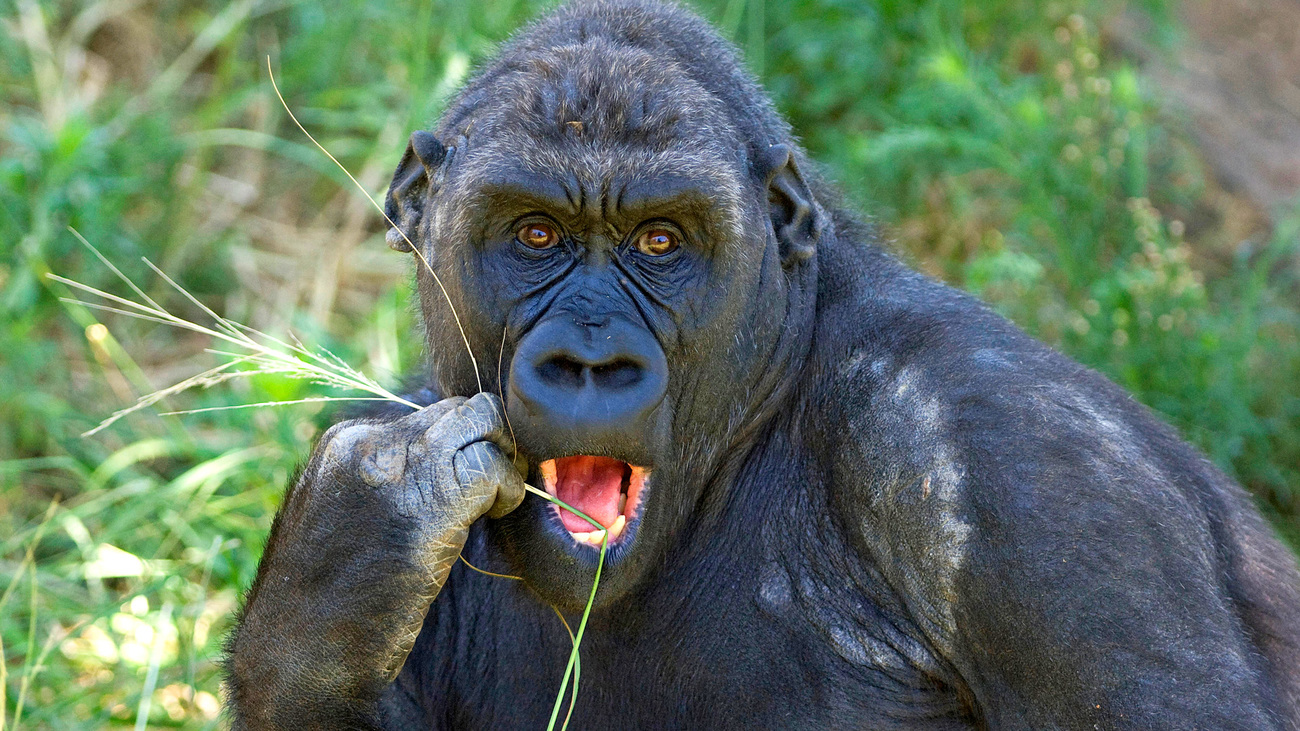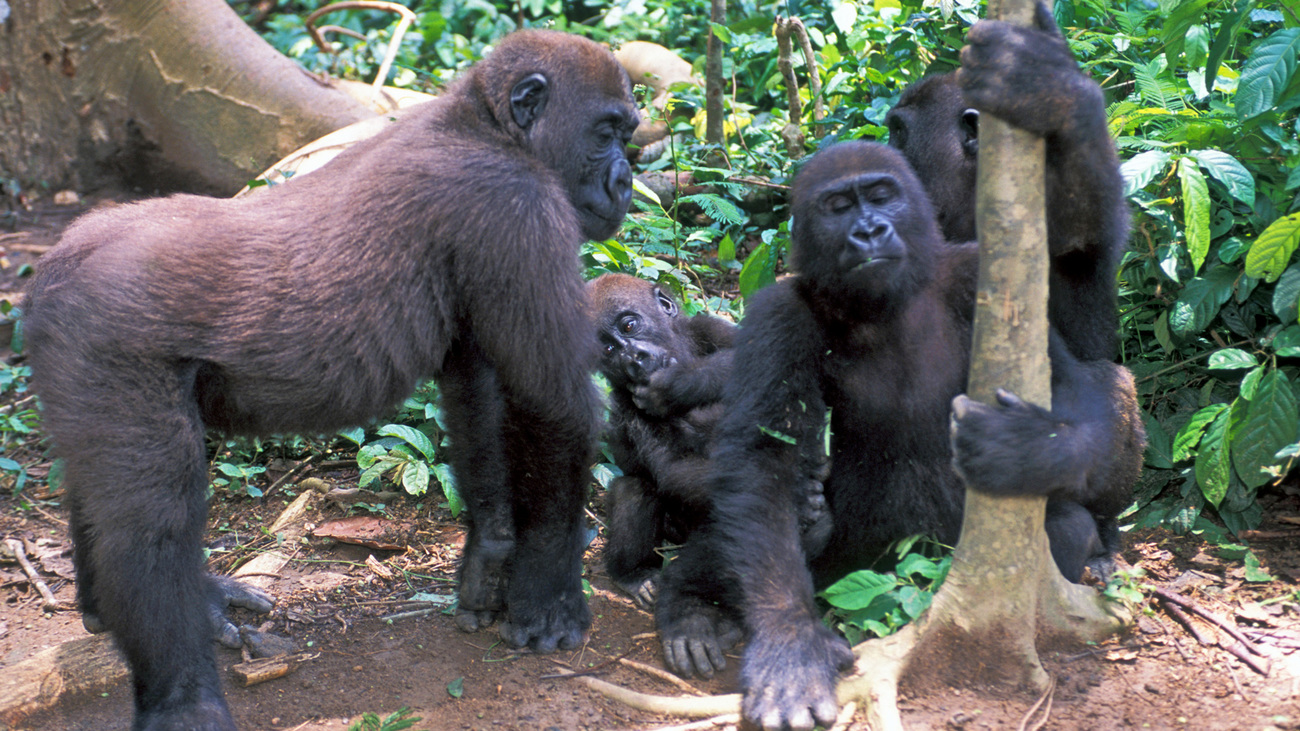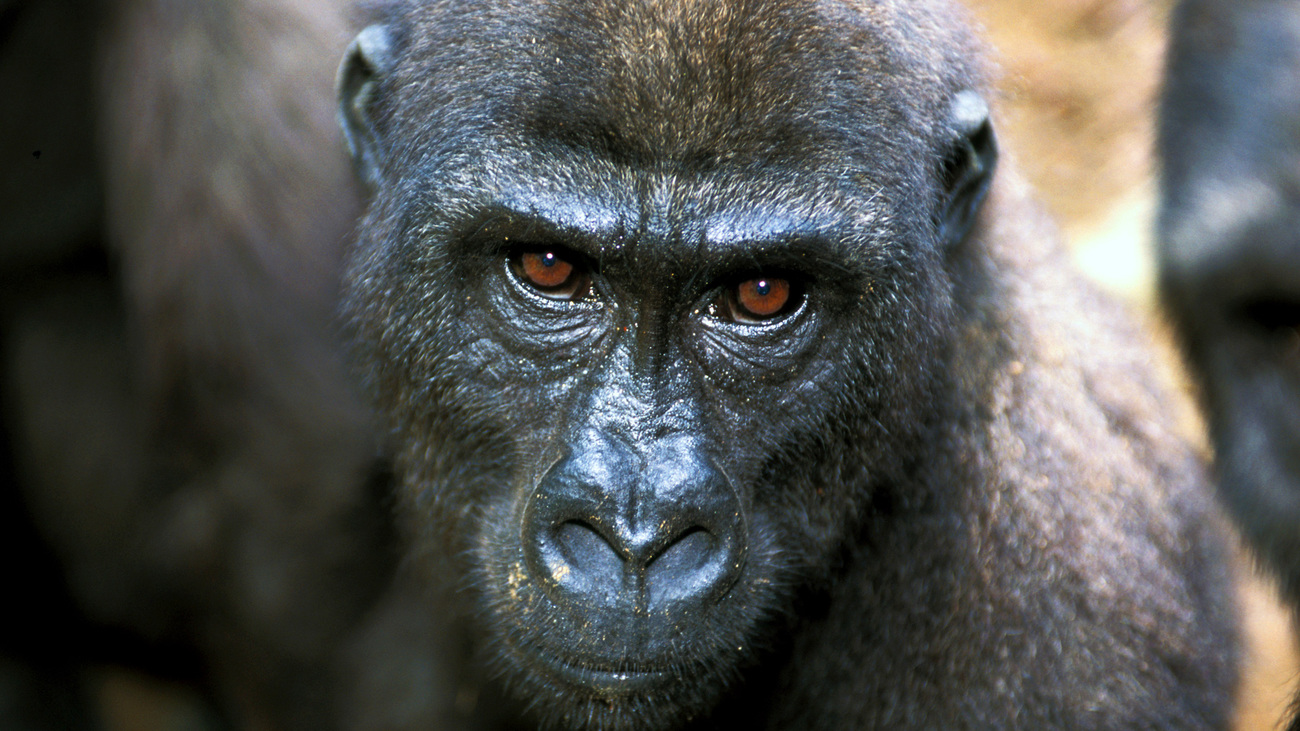Western lowland gorillas
What is a western lowland gorilla?
The western lowland gorilla is one of two subspecies of the western gorilla, the other subspecies being the Cross River gorilla. Western lowland gorillas are the smallest gorillas. They are also the most widespread. They live in lush rainforests across 700,000 square kilometres (270,000 square miles) in Central Africa. Male western lowland gorillas are much larger than females, reaching an average weight of 136 kilograms (300 pounds) and an average height of 1.8 metres (6 feet). Females have an average height of 1.4 metres (4.5 feet) and weigh between 68-90 kilograms (150-200 pounds).
Compared to other gorilla subspecies, they’re also lighter in colour and have a face shape with a more pronounced brow ridge and smaller ears.
Western lowland gorillas are primarily herbivores, eating various rainforest vegetation, including fruits, roots, herbs, shrubs, vines, and shoots. They supplement this diet with some small insects they find on the vegetation they eat, like ants and other invertebrates, which act as an extra source of protein. A male western lowland gorilla can eat as much as 20 kilograms (45 pounds) of food daily.
Western gorillas are social animals and live in groups (called ‘troops’) of 2 to 30 individuals. Most groups have around five members, including a silverback male, potentially some younger blackback males, and several females, plus their infants. Females usually leave their birth groups once they reach sexual maturity to find a mate and join a new group. Males also leave their birth groups but typically go through a ‘bachelor’ phase while they mature enough to win a mate. During this time, they live alone or in all-male groups. The silverback leader of a group has exclusive mating rights to all females, though he can also choose to let other blackback males mate with them.
Gorillas spend their days and nights in nests. During the day, they find a comfortable resting spot and use foliage and branches to form a nest. Males tend to prefer the ground, while females sometimes nest in trees. At night, they also make nests for sleeping. Infants share nests with their mothers and start making their own when they’re around three years old.
Gestation in lowland gorillas lasts around nine months, and females typically reproduce every four to five years. An infant is born knowing to latch onto their mother’s chest so she can carry them around. Mothers care for their infants for up to five years.
Western lowland gorillas are what’s known as an umbrella species that indirectly protects other species around them. Part of this is due to the wide area they inhabit. Western lowland gorillas play a role in maintaining biodiversity by pruning plants and trees to promote sunlight and growth and spreading seeds so plants can expand to new areas.
What is a western lowland gorilla’s scientific name?
The scientific name of the western lowland gorilla is Gorilla gorilla gorilla. The western gorilla’s species name is Gorilla gorilla, and the subspecies name is G. g. gorilla.
The word ‘gorilla’ has uncertain origins. It was first used by American naturalist Thomas S. Savage in 1847. He reportedly chose it based on an account from Hanno, a Carthaginian navigator, who used the Greek word gorillai to describe a group of indigenous people he encountered along the northwest coast of Africa in 500 BCE.
Are western lowland gorillas endangered?
Western lowland gorillas are considered critically endangered by the IUCN. Researchers estimate that western lowland gorillas lose 2.7% of their population annually. Between 2005 and 2071 (over three generations), western lowland gorillas will likely lose as much as 80% of their population. They are mainly threatened by habitat loss, poaching, and disease.
Where do western lowland gorillas live?
The western lowland gorilla is the most widespread of all the gorilla subspecies, covering an area of 700,000 square kilometres (270,000 square miles) across Cameroon, Central African Republic, Democratic Republic of the Congo, Equatorial Guinea, Gabon, and Angola. Most live at low elevations, but some live in the mountains of Gabon.
The western lowland gorilla’s habitat is a thick rainforest with abundant shoots, roots, wild celery, fruits, pulp, and tree bark. Temperatures in these rainforests are usually between 20 and 30 degrees Celsius (68 and 86 degrees Fahrenheit), and annual precipitation can surpass 2,000 millimetres (79 inches).
Threats
Western lowland gorillas face several threats that are reducing their numbers at an alarming rate. These include habitat loss, poaching, and disease.

Habitat loss
Western lowland gorillas were largely safe from habitat loss for a long time because their rainforests were inaccessible to humans, so little infrastructure was built throughout their range.
However, Africa has recently become a popular location for oil palm plantations, and 73% of the western lowland gorilla’s habitat is suitable for growing oil palm. Mining has also increased in the area, which disturbs wildlife and leads to habitat loss.
Poaching
Although it’s illegal to hunt gorillas for bushmeat, government and law enforcement in the area are weak, and both bushmeat and ivory are still trafficked out of the rainforests. As infrastructure makes it easier and easier for hunters to reach deeper into the forest and easily transport bushmeat out to the cities, poaching rates are increasing. This is the case not just for the western lowland gorillas but all four subspecies of gorillas.
Disease
Western lowland gorillas are especially susceptible to the Ebola virus disease (EVD), which is brought to their habitats by humans. Since the 1990s, there have been several large-scale die-offs in the area, totalling tens of thousands of gorillas and chimpanzees. Because gorillas share 96% of their DNA with humans, they are highly susceptible to human diseases but cannot fight them off like we can.
FAQs
How many western lowland gorillas are left?
According to surveys and population decrease calculations, the IUCN estimates a western lowland gorilla population of around 316,000 individuals. However, their numbers are rapidly decreasing due to a mixture of disease, poaching, and habitat loss.
Why are western lowland gorillas going extinct?
Western lowland gorilla numbers are decreasing due to several factors, two of the most urgent of which are poaching and disease. Growing road infrastructure has made it easier for hunters to traverse previously inaccessible parts of the forest, allowing them to reach gorillas. The increased human presence in gorilla habitats also brings new diseases that the gorillas can’t fight. The most common of these is the Ebola virus, which has killed tens of thousands of both gorillas and chimpanzees in the past few decades.
What is the world’s largest gorilla?
The eastern lowland gorilla is the largest gorilla. Male eastern lowland gorillas weigh around 163 kilograms (360 pounds).
The western lowland gorilla is the smallest gorilla subspecies. Males weigh an average of 136 kilograms (300 pounds), and females weigh 68 to 90 kilograms (150 to 200 pounds).

Do western lowland gorillas eat meat?
Gorillas don’t eat meat, but they do eat bugs. Their omnivorous diet mainly consists of roots, shoots, fruit, tree bark, and other vegetation. They sometimes eat insects like ants.
Is a western lowland gorilla a silverback?
Silverback is the name given to adult male gorillas that reach a certain age. The name comes from the silvery white hair that grows across the small of their back and extends to their rump and thighs.
What is the predator of the western lowland gorilla?
Lowland western gorillas have no natural predators and don’t fight with other species in their habitat. They do, however, have one unnatural predator—humans. As well as creating problems with gorilla habitats through the building of infrastructure, humans also hunt gorillas for bushmeat and transmit deadly diseases like the Ebola virus to gorilla populations.
How strong is a western lowland gorilla?
One of the most startling facts about lowland gorillas is that their strength is estimated to be around 10 times their body weight. Silverbacks (male adults) can lift as much as 1,810 kilograms (4,000 pounds), while the human record is 501 kilograms (1,105 pounds).
What threatens western lowland gorillas?
The biggest threats to western lowland gorillas are habitat loss, poaching, and disease. Logging, commercial hunting and fishing, and oil and gas development damage and reduce gorillas’ habitat. Gorillas are susceptible to diseases carried by humans and also face poaching.
Are western lowland gorillas friendly?
While King Kong might have given you a different impression, gorillas are primarily quiet and peaceful animals. The most common causes of violence among gorillas are related to reproduction. Males will fight over females, and when a new male becomes the leader of a group, he may kill infants that aren’t his to ensure females are ready to mate again sooner.
While gorillas won’t attack unless provoked, it’s unsafe for humans to approach them. They are incredibly strong and may attack when startled or feeling threatened.
How long do western lowland gorillas live?
In the wild, western lowland gorillas usually live for 30 to 40 years. In captivity, some can survive for longer than 40 years.
How do western lowland gorillas communicate?
Gorillas communicate using sounds, body language, and smells. Researchers have observed over 20 different gorilla vocalisations with distinct meanings. These sounds are often subdued, such as grunts, hoots, pants, chuckles, and belches. However, gorillas also bark, scream, and roar. According to studies, they can also modify their odours for social communication.
When communicating, they often approach other gorillas in specific ways depending on the social situation. Crouching low and approaching from the side shows submission, while standing shows confidence, and chest-slapping shows aggression.
The western lowland gorilla’s communication capabilities don’t stop there. Koko, a western lowland gorilla, learned over 1,000 words in sign language and conversed with human scientists. She understood over 2,000 spoken words, responded to many types of questions, and even showed traits like humour.
How can you help?
Western lowland gorillas are threatened by habitat loss due to palm oil production. If you can, avoiding palm oil products is one way to help protect these gorillas and other animals.
Poaching is also a major threat to gorillas. By supporting conservation organisations, you can help support anti-poaching initiatives.
